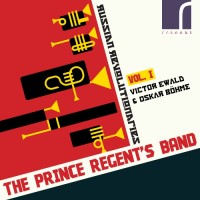 The Prince Regent’s Band, Russian Revolutionaries Vol.1: Victor Ewald & Oskar Böhme. Resonus Classics (RES10201), 2016.
The Prince Regent’s Band, Russian Revolutionaries Vol.1: Victor Ewald & Oskar Böhme. Resonus Classics (RES10201), 2016.
Richard Fomison, soprano cornet in E-flat, cornet in B-flat, rotary valve trumpet in B-flat; Richard Thomas, cornet in B-flat, rotary trumpet in B-flat; Fraser Tannok, cornet in B-flat, rotary trumpet in B-flat; Anneke Scott, rotary valve althorn in E-flat, rotary valve horn in E-flat; Phil Dale, rotary valve tenor horn in B-flat, baritone in B-flat, rotary valve tenor trombone, slide trombone; Emily White, tenor slide trombone; Jeff Miller, bass slide trombone in B-flat/ F, rotary valve bass tuba in F. www.princeregentsband.com
The Prince Regent’s Band is among the most notable of period brass ensembles active in the field today. Those fortunate to have heard them play, as this reviewer has, can attest to the accomplished and dedicated efforts to expertly recreate the sounds and performances of the time when these instruments were originally made and played.
This survey of the brass chamber music of Victor Ewald, And Oscar Bohme, fulfills the ensemble’s mission with compelling performances of the wonderful and engaging chamber music the public heard in nineteenth-century Russia, on the newly perfected chromatic piston instruments. Specifically, these works originate from the brass school of composition and performance centered in St Petersburg, in the later part of the nineteenth century.
Remarkably, a photograph of a brass ensemble of Russian nobility is included in the extensive album notes. It shows the performing players to all be Russian Princes, Dukes, Generals, as an octet. The nobility’s hands-on interest in the brass instruments of the era certainly gave composers ample opportunity to create and have performances of dignified and satisfying works.
The Prince Regent’s Band has recorded beautifully a sextet, two quartets, two quintets and a trio of Oskar Böhme, as well as two Ewald Quintets. (Opus 5 and 6). The recording is superbly annotated by Anneke Scott, giving excellent historical context and well as very specific scholarship regarding each works performed. The notes also include an informed discussion of the instruments and most satisfying to HBS members, the individual instruments used are indexed and with precise detail; every track on the recording is identified by performer and the instrument used. A more helpful approach for our HBS interests could not be devised.
The playing is uniformly wonderful, and the performances as recorded are inspired, expressive, and indeed virtuosic. They played these works and instruments without hesitation or apparent limitations. Dynamics, registers, intonation, balances, and quality of sound all show the players abilities to be accomplished as well as their mastery of these instruments, all dating from the period.
One notable piece which was recorded was the Opus 44 Nachtmusic, of Bohme. A pensive, expressive and sustained work of beautiful sonorities, this music is played with complete and full sustained harmonic richness. The chromatic effects of the music were haunting and remarkably done.
Böhme’s Sextet in E-flat minor, Opus 30 is also notable for its musical content. The Prince Regent’s Band play the four- movement work with great feeling. The Adagio is prayerful, the upper notes flow lyrically with great control at all dynamics. The Scherzo movement is rhythmical, with a relaxed cushioned sound, never pushed. The Andante Cantabile displays a choral style of harmonic richness, with soaring climaxes. The concluding Allegro Spiritoso is triumphant and celebratory, with fanfares, joyous melodic content, brilliant crescendos, startling fortissimos, and a spirited conclusion with coda. The performances defy you to detect limitations of these “old” instruments.
-- Frank Hosticka



